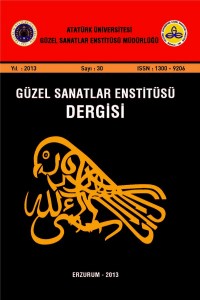Abstract
Script, called by various names in Hejaz region in the early stages of Islam, mostly called as Kufic. While same type of Kufic was being used in Eastern regions, Maghrebi Kufic which is a little different than the original Kufic was preferred in Andalusia and Maghreb. Different font types were derived from Kufic style in Islamic World later on and they superseded this style. People in the region began to become Muslim starting with the spread of Islam in North Africa have shown diligence and Mushaf writing gained importance. It can be seen that statesmen such as caliphs, sultans, ameers and viziers were the biggest supporters of development and deployment of writing. Many scribal, calligraphers and stationers were raised in Maghreb and Andalusia. In addition to these, art of decorations, book copying and bookbinding were developed. Andalusian stationers had been the most adept stationers of all in those times. As with most of artists, biographies and works of many artists who were raised in this region could not reach us sufficiently. Muslims have strived to construct mosques for worship, spread sciences such as Quran, Hadith, Fiqh and cultivate virtuous people using these sciences in human life.
Keywords
References
- Afîf el-Behnesî, Mu‘cemü Mustalahâti’l-Hatti’l-‘Arabî ve’l- Hattatîn, Beyrut 19 Alparslan, Ali, “İslam Yazıları”, Hat ve Tezhip Sanatı, Editör, Ali Rıza Özcan, Ankara 2009, s. 30. ar.wikipedia.org/wiki/ ﻲﺴﻟﺪﻧﺃ ﻂـﺧ (13.11.2011)
- Birışık, Abdülhamit, “Kıraat”, DİA, Ankara 2002, 25/426.
- Bolelli, Nusrettin, “Hattat Kadınlar”, İslâmî Edebiyat, II/2, İstanbul 1989, s. 32Çetin, M. Nihad, “İslâm Hat Sanatı’nın Doğuşu ve Gelişmesi”, İslâm Kültür Mirasında Hat Sanatı, İstanbul 1992.
- Çetin, M. Nihad, “Arap” DİA, İstanbul 1991, 3/276-282.
- Derman, M. Uğur, Sakıp Sabancı Müzesi Hat Koleksiyonundan Seçmeler, İstanbul 2002.
- Derman, M. Uğur, “Hat” DİA, İstanbul 1997, 16/427-437.
- Derman, M. Uğur, İslâm Türk Mirâsında Hat Sanatı, İstanbul 1994.
- Habîb, Hat ve Hattâtân, Kostantiniyye 1305.
- Harekât, İbrahim, “Mağrib”, DİA, Ankara 2003, 27/314-318.
- Henâ Muhammed, http://alzhour.com/culturedetails_print.asp?CID=12501
Abstract
İslâm’ın ilk dönemlerinde Hicaz bölgesinde farklı isimlerle
adlandırılan yazı daha çok kûfî diye şöhret bulmuştur. Doğu bölgelerinde
aynı kûfî kullanılırken Endülüs ve Mağrib’de asıl kûfîden biraz farklı olan
“Mağrib kûfîsi” tercih edilmiştir. Daha sonra İslam âleminde kûfîden doğan
farklı yazı çeşitleri türemiş ve kûfînin yerini almıştır.
Kuzey Afrika’da İslâmiyet’in yayılmaya başlamasıyla Müslüman
olmaya başlayan bölge insanı ilk dönemlerden itibaren yazıya gereken
ihtimamı göstermiş ve Mushaf yazımı önem kazanmıştır. Yazının
gelişmesinde ve yayılmasında halife, sultan, emir ve vezir gibi devlet
adamlarının büyük pay sahibi olduğu görülmektedir.
Mağrib ve Endülüs’te birçok müstensih, hattât ve verrâk yetişmiştir.
Bunun yanında bezemecilik, kitap istinsahı ve ciltçilik sanatları da
gelişmiştir. Endülüslü verrâklar en mâhir verrâklar olmuştur. Pek çok
sanatkârda olduğu gibi burada yetişen birçok sanatkârın biyografi ve eserleri
de yeterince elimize ulaşamamıştır. Müslümanlar ibadet için mescitler inşâ
etmeye; Kur’ân, hadîs, fıkıh vs. ilimleri yaymaya ve bunları insan hayatında
etkili kılarak erdemli insanlar yetiştirmeye gayret etmişlerdir.
References
- Afîf el-Behnesî, Mu‘cemü Mustalahâti’l-Hatti’l-‘Arabî ve’l- Hattatîn, Beyrut 19 Alparslan, Ali, “İslam Yazıları”, Hat ve Tezhip Sanatı, Editör, Ali Rıza Özcan, Ankara 2009, s. 30. ar.wikipedia.org/wiki/ ﻲﺴﻟﺪﻧﺃ ﻂـﺧ (13.11.2011)
- Birışık, Abdülhamit, “Kıraat”, DİA, Ankara 2002, 25/426.
- Bolelli, Nusrettin, “Hattat Kadınlar”, İslâmî Edebiyat, II/2, İstanbul 1989, s. 32Çetin, M. Nihad, “İslâm Hat Sanatı’nın Doğuşu ve Gelişmesi”, İslâm Kültür Mirasında Hat Sanatı, İstanbul 1992.
- Çetin, M. Nihad, “Arap” DİA, İstanbul 1991, 3/276-282.
- Derman, M. Uğur, Sakıp Sabancı Müzesi Hat Koleksiyonundan Seçmeler, İstanbul 2002.
- Derman, M. Uğur, “Hat” DİA, İstanbul 1997, 16/427-437.
- Derman, M. Uğur, İslâm Türk Mirâsında Hat Sanatı, İstanbul 1994.
- Habîb, Hat ve Hattâtân, Kostantiniyye 1305.
- Harekât, İbrahim, “Mağrib”, DİA, Ankara 2003, 27/314-318.
- Henâ Muhammed, http://alzhour.com/culturedetails_print.asp?CID=12501
Details
| Primary Language | tr;en |
|---|---|
| Journal Section | Articles |
| Authors | |
| Publication Date | November 19, 2013 |
| Submission Date | November 19, 2013 |
| Published in Issue | Year 2013 Issue: 30 |
Obtaining permissions for studies requiring ethics committee approval regarding the implementation of ethical rules and including information about permission in the article was added to the criteria. In this direction, Ethics Committee Permission is required for articles submitted to our journal and meeting the conditions stated below.
• Any research conducted with qualitative or quantitative approaches that require data collection from participants using questionnaires, interviews, focus group work, observation, experimentation, and interview techniques.
Also;
• Obtaining and indicating permission from the owners for the use of scales, surveys and photographs belonging to others,
• It should be stated that the copyright regulations are complied with for the intellectual and artistic works used.

